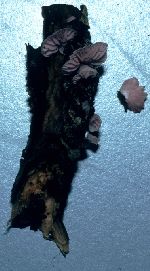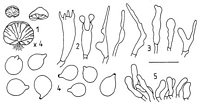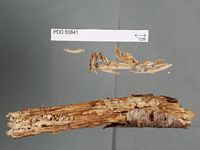|
 Cheimonophyllum roseum Cheimonophyllum roseum
BiostatusPresent in region - Indigenous. Endemic
Images (click to enlarge)
Owner: B.P. Segedin | 
Caption: 1, Basidiomes x4; 2, basidia; 3, cells from cap margin; 4, spores; 5, pileipellis. (Magnifications, see Fig. 1.) | 
Caption: Dried type specimen
Owner: Herb PDD |
Article: Segedin, B.P. (1994). Studies in the Agaricales of New Zealand: new records and new species of the genera Cheimonophyllum, Mniopetalum, and Anthracophyllum (Tricholomataceae, Collybieae). New Zealand Journal of Botany 32: 61-72 (http://www.rsnz.org/publish/abstracts.php).
Description: Basidiomes 3-7 mm diam., pale rose pink (10A34), colour retained on drying or sometimes darkening (10A6), attached to the substratum either laterally with a dense subiculum of white hyphae or by a lateral extension of the pileus. Basidiome extremely brittle when dried. No stipe seen. Pileus fan-shaped to reniform, convex with an inrolled margin when young, flattening with age; surface velutinous (near the margin) to villose. Lamellae well-developed, subdistant, thin, relatively broad, slightly ventricose, in 2-3 series, 5-8 principal ones converging to an excentric point; lamellar margin even and concolorous. Taste and smell unknown. Spore print unknown.
Spores 6.5x4-6.5 (5.2x5.l)µm, Q= 1.01, globose to sub-globose, occasionally broadly pyriform, hyaline, inamyloid, not dextrinoid, acyanophilic, wall very thin, collapsing easily, apiculus usually short and distinct, occasionally extending gradually from the spore to give the pyriform spore outline, often with a distinct subterminal scar. Basidia 20-22 x 8 µm, subcylindrical to clavate, relatively short and stout, extending slightly at maturity; sterigmata (2)-4, 3-4 µm long, often scarred apically. Cheilocystidia and pleurocystidia absent. Trama fairly dense, somewhat bilateral with a central region of more or less parallel hyphae, 3-4 µm diam., lateral hyphae more interwoven, slightly divergent, merging into the narrow, filamentous subhymenium. Context of fairly densely packed hyphae, 5-6 µm diam., more parallel than interwoven and difficult to squash, merging into the loosely arranged pileipellis region with upturned hyphal endings responsible for the velutinous appearance and bundles of narrower hyphae for the villi. The pileus margin is heteromorphous, composed mainly of short, cylindrical to subclavate, flexuose to geniculate hyphal endings, some basidia and a number of more irregular cells basically narrow-subulate with a distinctive, long narrow neck. All hyphae have conspicuous clamp connections, and there was no indication of a gelatinisation.
Habitat: Gregarious on dead wood on the ground in Nothofagus forest.
Notes: The name reflects the all-over pink colour of the basidiomeCheimonophyllum roseum was found quite commonly on dead twigs and branches of Nothofagus fusca and a N. menziesii in the Lewis Pass area. Its all-over shell-pink colour makes it quite distinctive as compared with other described species of the genus, which are all reported to have white basidiomes. It also has broader lamellae, without interveining, and lacks a stipe. As in C. candidissimum, no zone of cheilocystidia was found, but some awl-shaped cells were found on pileus margins of C. roseum. These are very similar to the awl-shaped cheilocystidia described by Horak (1968) and Pegler (1983) for C. candidissimum, and are also believed to be hyphal outgrowths from the trama or context, as described by Reijnders & Stalpers (1992).
|